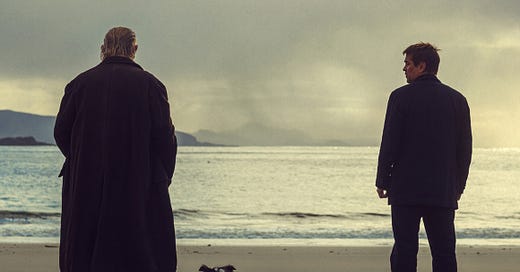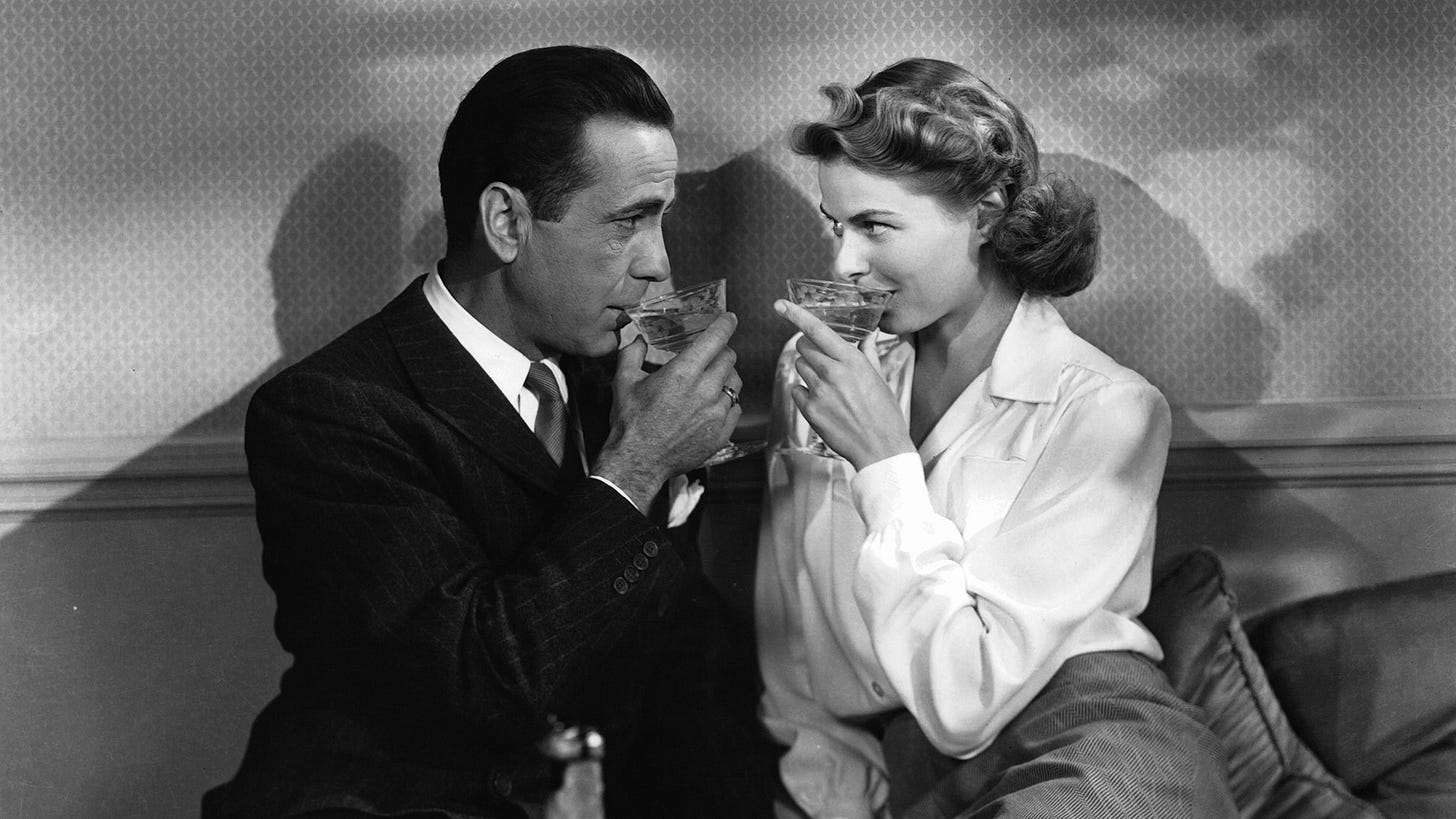Ready, Set, SET: Time and Place in Film
How where you are affects who you are, why The Banshees of Inisherin makes you cry, and what makes Casablanca one of the greatest films of all time.
Everything in a story is intentional.
The main character is crafted specifically to embark on some sort of quest that will reveal some theme.
The plot of the story is charted out carefully to ensure that the protagonist’s journey is satisfying and logical.
The side characters are invented to serve the protagonist on their journey and cause character growth.
And so on. It’s an obvious fact, but also one that is easy to overlook, that the writer has invented everything in the story to serve some purpose.
One such invention is the setting: when and where a story takes place.
Sometimes, the setting can be integral to the plot. Disney-Pixar’s Inside Out (2015), for example, takes place inside of a brain. You can’t keep the plot of Inside Out and set the movie in, say, the gall bladder. Or Las Vegas. Or an airplane. It just doesn’t work.
Then there’s a movie like Ambulance (2022), a film in which two men botch a bank heist and hijack an ambulance as their getaway vehicle. The subsequent hour and forty-five minutes could play out almost anywhere and the movie would remain pretty much the same.
So you see, the setting can inform the plot, but it doesn’t have to. Instead, the most important role that a film’s setting can have is to drive home the theme of the film. A strong setting can be the difference between a bland snoozefest and a thought-provoking masterpiece.
Today we’re going to look at two acclaimed movies released 80 years apart from each other. We’ll explore both the where and the when and consider how the writers’ choices of setting elevated their films.
Part I. Who?
Let’s meet the films in the question:
The Banshees of Inisherin (2022)
Screenplay by Martin McDonagh
Where: Inisherin, an island off the coast of Ireland.
When: Spring of 1923
What: Colm doesn’t want to be friends with Pádraic anymore.
Casablanca (1942)
Screenplay by Julius J., Philip G. Epstein, and Howard Koch
Where: Casablanca, a city in Morocco
When: December 1941
What: Rick wants to be more-than-friends with Isla again.
Part II: Where?
First things first, Inisherin doesn’t really exist: it’s a made-up island off of the coast of Ireland (Inisherin translates to Island of Ireland). This is a hint that the location matters a great deal to the story that Martin McDonagh (the writer) is telling. If the story could unfold anywhere, he wouldn’t have felt the need to create his own island.
The setup for the movie is simple enough: two drinking mates, Pádraic and Colm, break up after Colm unilaterally ends their relationship. On the surface, this feels like a plotline that could play out anywhere. Why did McDonagh feel compelled to invent an island for this story?
If you’ve watched the film (and you should, if you haven’t already), you know that this is a crushing movie. Hilarious at times, sure, but also devastating.
Why?
Because Pádraic is trapped.
He was born and raised here. All he has ever known is this small, quiet island where everyone knows everyone. They all meet up at the pub in the afternoon. They all go to church on Sunday. No one enters; no one leaves.
So when Colm decides that he would like to end his and Pádraic’s friendship, it’s not like Pádraic can turn around and befriend someone else.
There is no one else.
That was his one friend.
This is the central problem of the film. Sure, Pádraic has his sister and his livestock. But he’ll never have another friendship like the one he shared with Colm.
Then, as the events of the movie progress and Pádraic gradually loses everything he cares about, the audience knows what Pádraic refuses to admit: there is no way out.
This claustrophobic island is Pádraic’s personal hell; he can’t leave, but he can’t stay. He is entrenched in conflict, both external with Colm and internal with his own mental health.
McDonagh manufactured the film’s physical location specifically to exacerbate this conflict. Inisherin is unflinching and immutable. Its inherent loneliness crushes Colm and Pádraic, plunging both of them into states of deep, yet unspoken, depression which cause their quarrel to escalate rapidly over the course of the movie.
It’s a tremendous film, one that forces the audience to experience the dire hopelessness of Pádraic’s circumstance. We understand why he cannot bring himself to leave, but we also are fully aware that every second he stays on Inisherin he is further lost to his inner anguish.
Part III: When?
Both Banshees of Inisherin and Casablanca are period pieces. That is to say, they take place in a time that is not the present.
Casablanca takes place in December 1941. We’re in the throes of World War II. Nazi forces have spread across Europe, leaving a trail of destruction, death, and refugees. The French still control Casablanca, but the Nazis are closing in around it. We’re also pre-Pearl Harbor, meaning that the US is still neutral.
At this moment in history, Casablanca is a nexus. It is where people from all across Europe gather in the hopes of obtaining letters of transit that allow for travel to Lisbon, Portugal (then neutral) and subsequently the U.S. Although a wealthy (or perhaps lucky) few succeed in leaving, the majority can only “wait and wait and wait,” as the narration that opens the film explains, as the war grows fiercer and their chances of escape dwindle.
In other words: Inisherin was hell; Casablanca is purgatory.
Rick owns a bar in Casablanca in which he is famously neutral. He does not drink with any of his guests. He does not get involved in local affairs. He does not support the rebels, and he certainly does not support the Nazis. As a rule, he refuses to stick his neck out for anyone.
And then Ilsa Lund enters the establishment.
(They used to canoodle in Paris.)
With her husband.
(Rick didn’t know she had a husband.)
Needless to say, this is another movie you should watch if you haven’t; it’s a classic for a reason. I won’t spoil too much other than to say that this movie doesn’t work nearly as well if it’s set anywhere else or anytime else.
Speaking of which, let’s jump back to Banshees.
Why 1923? We’ve already discussed how the location furthers the sense of isolation and hopelessness; what purpose can the date serve?
This is where some more history comes into play: in the spring of 1923, the Irish Civil War was nearing its end.
Ah.
Throughout the film, characters standing by the waters of the island hear scattered gunshots from the mainland. They receive occasional news of the status of the war from the local general store. One character, the police captain of Inisherin, even participates in an execution. He remarks off-handedly that he doesn’t know which side the execution is for; he’s just excited to kill somebody.
The point is, this historical context colors the film in a very different light than if it had taken place in the present. The major themes, particularly the cyclical, unending nature of meaningless conflict and the despair that can result from it, are punctuated by its juxtaposition with the Irish Civil War.
What’s more, the pairing of conflicts allows us to understand both better:
I, knowing very little about this historical period in Ireland, am presented with a vivid metaphor for the war: that of two friends whose feud devolves into needless bloodshed and anger with no end in sight.
Simultaneously, not having met these characters until now, drawing a parallel from the off-screen war to their quarrel helps to escalate the conflict faster and more dramatically than if it was left to develop unaccompanied.
Casablanca works similarly, with a war playing out in the background of the characters’ conflicts. Casablanca interacts more directly with these external events, as Rick’s final decision in the film is directly informed by the affect that he will have on the war itself.
Part IV: Why?
Where would we be without setting?1
Writers have exploited the concept of setting for ages, situating their protagonists in the exact time period and precise location that will prompt the most change and create the most compelling story.
You might not expect a film about two drinking buddies to bring you to tears; you might not expect a love triangle from the 40s to remain one of the greatest films of all time. However, these films succeed in elevating their premises by surgically selecting settings that highlight the themes and conflicts of each story.
And then, before you know it, your Guinness tastes saltier than usual and you can’t get “As Time Goes By” out of your head.
Want to get ahead? Check out these films before my next post:
Creed (2015)
Swiss Army Man (2016)
Oppenheimer (2023)
PS. Feel free to guess the next topic of discussion in the comments! Winner gets a treat.
I am tremendously proud of this line.






